Compression Deformation Prediction of Chiral Metamaterials: A Compression–Shear Coupling Model
Abstract
:1. Introduction
2. A Mechanical Model for Large Deformations of Chiral Metamaterials under Uniaxial Compression
2.1. Parametric Analysis of Chiral Metamaterials
2.2. Equilibrium Equations for the Ligament Beam
2.3. Elliptic Integral Theory for Solving Large Deformations of Ligament Beam
2.4. Small Deflection Deformation of the Ligament Beam
2.5. Analysis of Cell Deformation under Uniaxial Compression
3. Ductile Deformation of Annular Nodes
3.1. Radial and Tangential Deformation under Annular Node Ductile Deformation
3.2. Compression-Shear Deformation of a Chiral Single Cell
4. Deformation Behaviour Analysis of Chiral Metamaterials under Uniaxial Compression
4.1. Structural Design of Chiral Metamaterials
4.2. Compression-Shear Coupling Deformation of a Two-Dimensional Planar Structure
4.3. Compression-Torsion Coupling Deformation of a Cylindrical Shell Structure
5. Conclusions
Author Contributions
Funding
Institutional Review Board Statement
Informed Consent Statement
Data Availability Statement
Conflicts of Interest
References
- Lake, R.S. Foam structures with a negative Poisson’s ratio. Science 1987, 235, 1038–1040. [Google Scholar] [CrossRef]
- Frenzel, T.; Kadic, M.; Wegener, M. Three-dimensional mechanical metamaterials with a twist. Science 2017, 358, 1072–1074. [Google Scholar] [CrossRef] [PubMed] [Green Version]
- Jiang, Y.Y.; Li, Y.N. 3D printed chiral cellular solids with amplified auxetic effects due to elevated internal rotation. Adv. Eng. Mater. 2017, 19, 1600609. [Google Scholar] [CrossRef]
- Prall, D.; Lakes, R.S. Properties of a chiral honeycomb with a Poisson’s ratio of −1. Int. J. Mech. Sci. 1996, 39, 305–314. [Google Scholar] [CrossRef]
- Theocaris, P.S.; Stavroulakes, G.E.; Panagiotopoulos, P.D. Negative poisson’s ratios in composites with star-shaped inclusions: A Numerical Homogenization Approach. Arch. Appl. Mech. 1997, 67, 274–286. [Google Scholar] [CrossRef]
- Hou, X.H.; Deng, Z.C.; Zhang, K. Dynamic crushing strength analysis of auxetic honeycombs. Acta Mech. Solida Sin. 2016, 29, 490–501. [Google Scholar] [CrossRef]
- Zhang, J.J.; LU, G.X.; Duan, R. Tensile behavior of an auxetic structure: Analytical modeling and finite element analysis. Int. J. Mech. Sci. 2018, 136, 143–154. [Google Scholar] [CrossRef]
- Fu, M.H.; Zheng, B.B.; Li, W.H. A novel chiral three-dimensional material with negative Poisson’s ratio and the equivalent elastic parameters. Compos. Struct. 2017, 176, 442–448. [Google Scholar] [CrossRef]
- Qi, D.X.; Zhang, P.; Wu, W.W.; Xin, K.H.; Liao, H.T.; Li, Y.; Xiao, D.B.; Xia, R. Innovative 3D chiral metamaterials under large deformation: Theoretical and experimental analysis. Int. J. Solids Struct. 2020, 202, 787–797. [Google Scholar] [CrossRef]
- Chen, W.; Huang, X.D. Topological design of 3D chiral metamaterials based on couple-stress homogenization. J. Mech. Phys. Solids 2019, 131, 372–386. [Google Scholar] [CrossRef]
- Alderson, A.; Alderson, K.L.; Chirima, G.; Ravirala, N.; Zied, K.M. The in-plane linear elastic constants and out-of-plane bending of 3-coordinated ligament and cylinder-ligament honeycombs. Compos. Sci. Technol. 2010, 70, 1034–1041. [Google Scholar] [CrossRef] [Green Version]
- Qi, D.X.; Lu, Q.Y.; He, C.W.; Li, Y.; Wu, W.; Xiao, D. Impact energy absorption of functionally graded chiral honeycomb structures. Extrem. Mech. Lett. 2019, 32, 100568. [Google Scholar] [CrossRef]
- Chen, W.; Ruan, D.; Huang, X.D. Optimization for twist chirality of structural materials induced by axial strain. Mater. Today Commun. 2018, 15, 175–184. [Google Scholar] [CrossRef]
- Bendsøe, M.P.; Kikuchi, N. Generating optimal topologies in structural design using a homogenization method. Comput. Methods Appl. Mech. Eng. 1988, 71, 197–224. [Google Scholar] [CrossRef]
- Allaire, G.; Jouve, F.; Toader, A.M. A level-set method for shape optimization. Comptes Rendus Math. 2002, 334, 1125–1130. [Google Scholar] [CrossRef]
- Wang, M.Y.; Wang, X.M.; Guo, D.M. A level set method for structural topology optimization. Comput. Methods Appl. Mech. Eng. 2003, 192, 227–246. [Google Scholar] [CrossRef]
- Bettini, P.; Airoldi, A.; Sala, G.; Landro, L.D.; Ruzzene, M.; Spadoni, A. Composite chiral structures for morphing airfoils: Numerical analyses and development of a manufacturing process. Compos. Part B Eng. 2010, 41, 133–147. [Google Scholar] [CrossRef] [Green Version]
- Huang, J.; Zhang, Q.H.; Scarpa, F.; Leng, J. In-plane elasticity of a novel auxetic honeycomb design. Compos. Part B Eng. 2017, 110, 72–82. [Google Scholar] [CrossRef] [Green Version]
- Wu, T.Y.; Li, M.X.; Zhu, X.L. Research on non-pneumatic tire with gradient antitetrachiral structures. Mech. Adv. Mater. Struct. 2020, 29, 2351–2359. [Google Scholar]
- Chen, H.; Zhu, F.; Jang, K.I.; Feng, X.; Rogers, J.A.; Zhang, Y.H.; Huang, Y.G.; Ma, Y.J. The equivalent medium of cellular substrate under large stretching, with applications to stretchable electronics. J. Mech. Phys. Solids 2018, 120, 199–207. [Google Scholar] [CrossRef]
- Zhong, R.; Fu, M.; Yin, Q.; Xu, O.; Hu, L. Special characteristics of tetrachiral honeycombs under large deformation. Int. J. Solids Struct. 2019, 169, 166–176. [Google Scholar] [CrossRef]
- Zheng, B.B.; Zhong, R.C.; Chen, X. A novel metamaterial with tension-torsion coupling. Mater. Des. 2019, 171, 107700. [Google Scholar] [CrossRef]
- Ma, Q.; Cheng, H.Y.; Jang, K.I.; Luan, H.W.; Hwang, K.C.; Rogers, J.A.; Huang, Y.G.; Zhang, Y.H. A nonlinear mechanics model of bio-inspired hierarchical lattice materials consisting of horseshoe microstructures. J. Mech. Phys. Solids 2016, 90, 179–202. [Google Scholar] [CrossRef] [PubMed] [Green Version]
- Ha, C.S.; Plesha, M.E.; Lakes, R.S. Chiral three-dimensional lattices with tunable Poisson’s ratio. Smart Mater. Struct. 2016, 25, 054005. [Google Scholar] [CrossRef]
- Alderson, A.; Alderson, K.L.; Attard, D.; Evans, K.E.; Gatt, R.; Grima, J.N.; Miller, W.; Ravirala, N.; Smith, C.W.; Zied, K. Elastic constants of 3-, 4- and 6-connected chiral and anti-chiral honeycombs subject to uniaxial in-plane loading. Compos. Sci. Technol. 2010, 70, 1042–1048. [Google Scholar] [CrossRef] [Green Version]
- Ma, C.; Lei, H.S.; Liang, J.; Wu, W.W.; Wang, T.J.; Fang, D.N. Macroscopic mechanical response of chiral-type cylindrical metastructures under axial compression loading. Mater. Des. 2018, 158, 198–212. [Google Scholar] [CrossRef]
- Davood, M.; Babak, H.; Ranajay, G.; Abdel, M.H.; Hamid, N.; Ashkan, V. Elastic properties of chiral, anti-chiral, and hierarchical honeycombs:A simple energy-based approach. Theor. Appl. Mech. Lett. 2016, 6, 81–96. [Google Scholar]
- Assidi, M.; Ganghoffer, J.F. Composites with auxetic inclusions showing both an auxetic behavior and enhancement of their mechanical properties. Compos. Struct. 2012, 94, 2373–2382. [Google Scholar] [CrossRef]
- Gonella, S.; Ruzzene, M. Homogenization and equivalent in-plane properties of two dimensional periodic lattices. Int. J. Solids Struct. 2008, 45, 2897–2915. [Google Scholar] [CrossRef] [Green Version]
- Mukhopadhyay, T.; Adhikari, S. Effective in-plane elastic properties of auxetic honeycombs with spatial irregularity. Mech. Mater. 2016, 95, 204–222. [Google Scholar] [CrossRef] [Green Version]
- Spadonia, A.; Ruzzene, M. Elasto-static micropolar behavior of a chiral auxetic lattice. J. Mech. Phys. Solids 2012, 60, 156–171. [Google Scholar] [CrossRef] [Green Version]
- Liu, J.X.; Yan, D.J.; Zhang, Y.H. Mechanics of unusual soft network materials with rotatable structural nodes. J. Mech. Phys. Solids 2021, 146, 104210. [Google Scholar] [CrossRef]
- Shim, V.P.W.; Quah, S.E. Solution of impact-induced flexural waves in a circular ring by the method of characteristics. J. Appl. Mech. Trans. Asme 1998, 65, 569–579. [Google Scholar] [CrossRef]
- BARBER, J.R. Force and displacement influence functions for the circular ring. J. Strain Anal. Eng. Des. 1978, 13, 77–81. [Google Scholar] [CrossRef]
- Ma, Q.; Zhang, Y. Mechanics of fractal-inspired horseshoe microstructures for applications in stretchable electronics. J. Appl. Mech. 2016, 83, 111008. [Google Scholar] [CrossRef]
- Liang, X.; Shan, J.P.; Zhou, X.; Li, S.; Yu, W.; Liu, Z.L.; Wen, Y.T.; Liang, B.; Li, H.J. Active design of chiral cell structures that undergo complex deformation under uniaxial loads. Mater. Des. 2022, 217, 110649. [Google Scholar] [CrossRef]
- Zhou, S.T. Design and Mechanical Property Analysis of Novel Chiral Compression Torsion Coupling Metamaterial; Harbin Institute of Technology: Harbi, China, 2019. [Google Scholar]
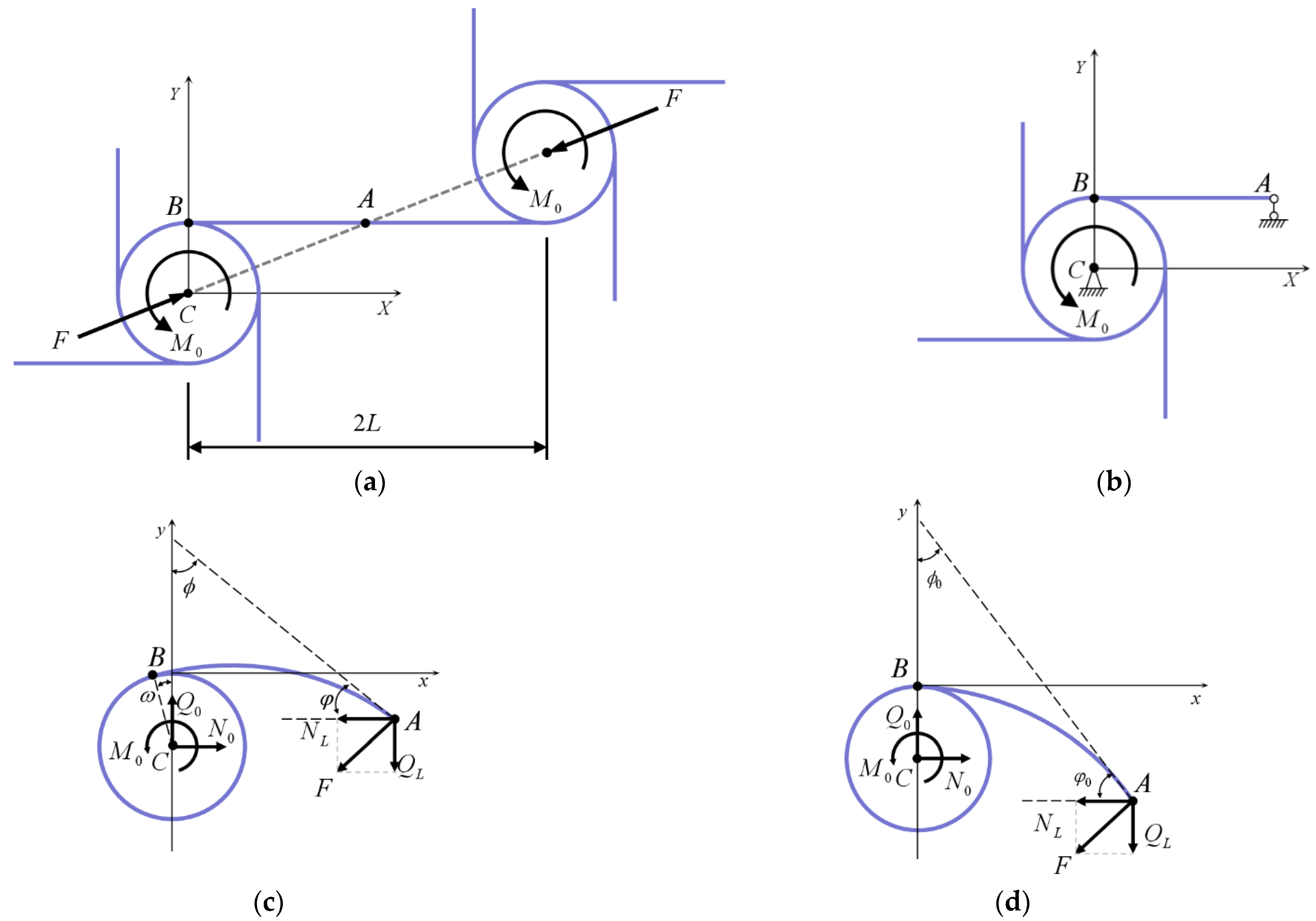
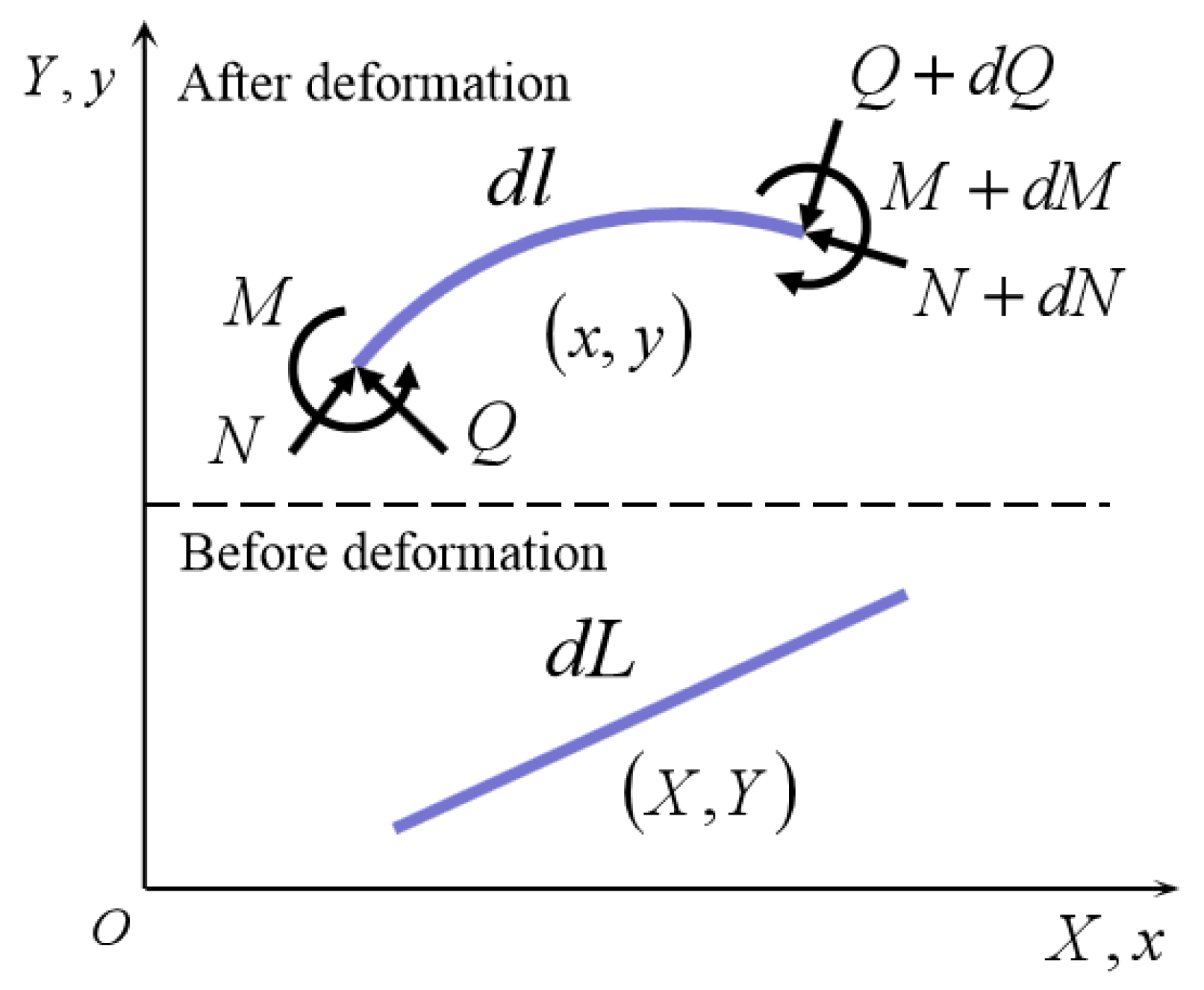

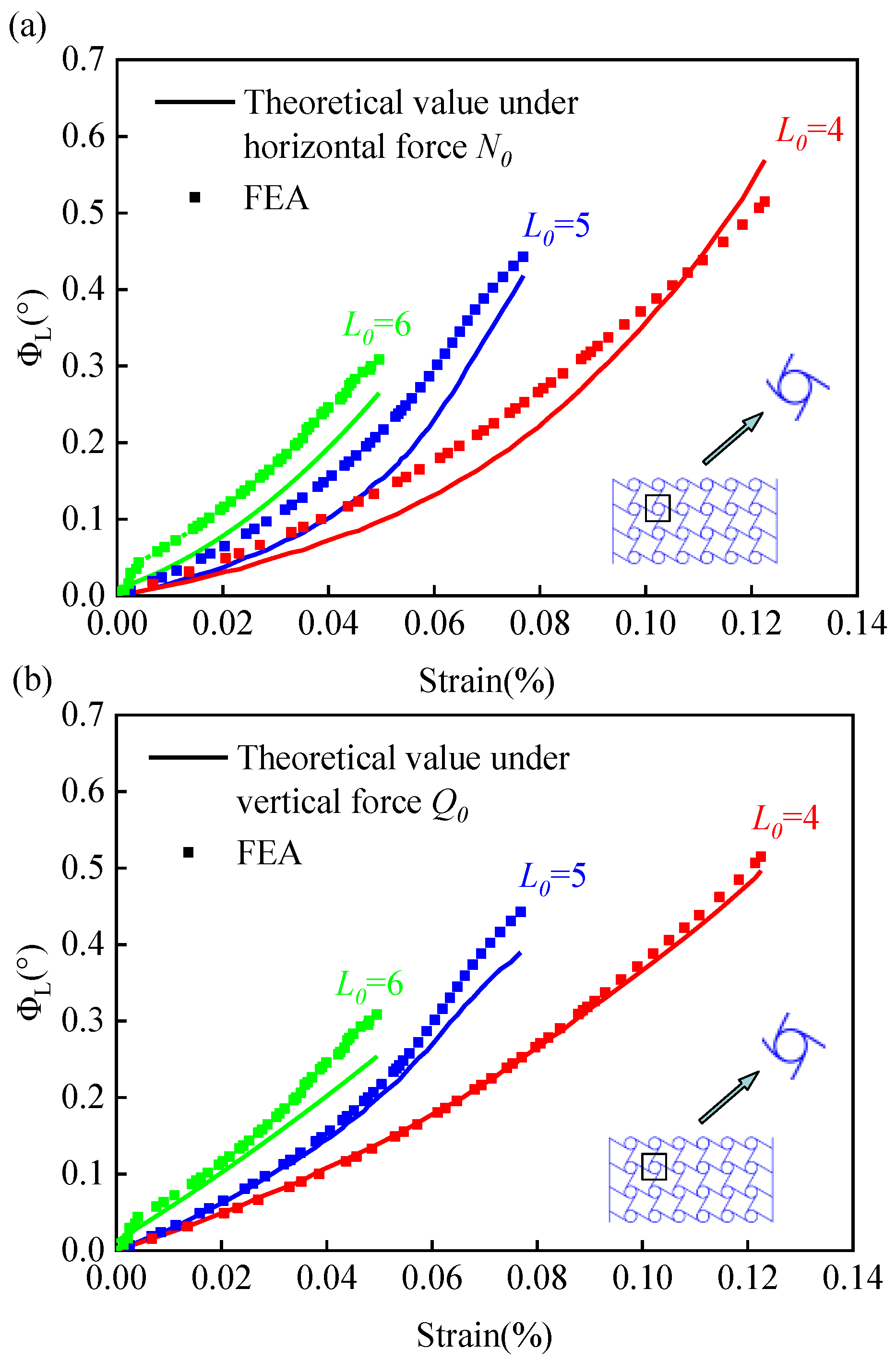
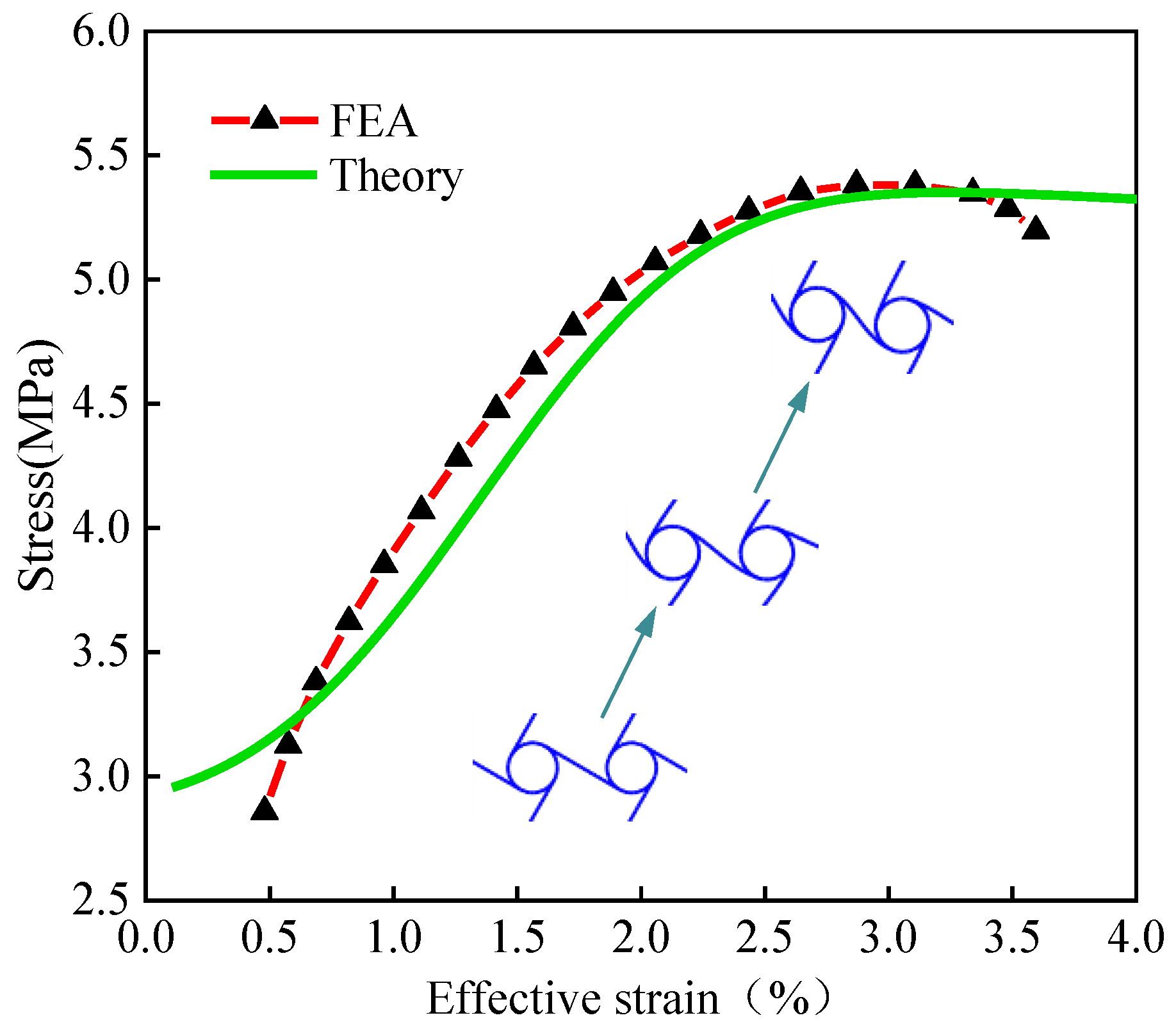
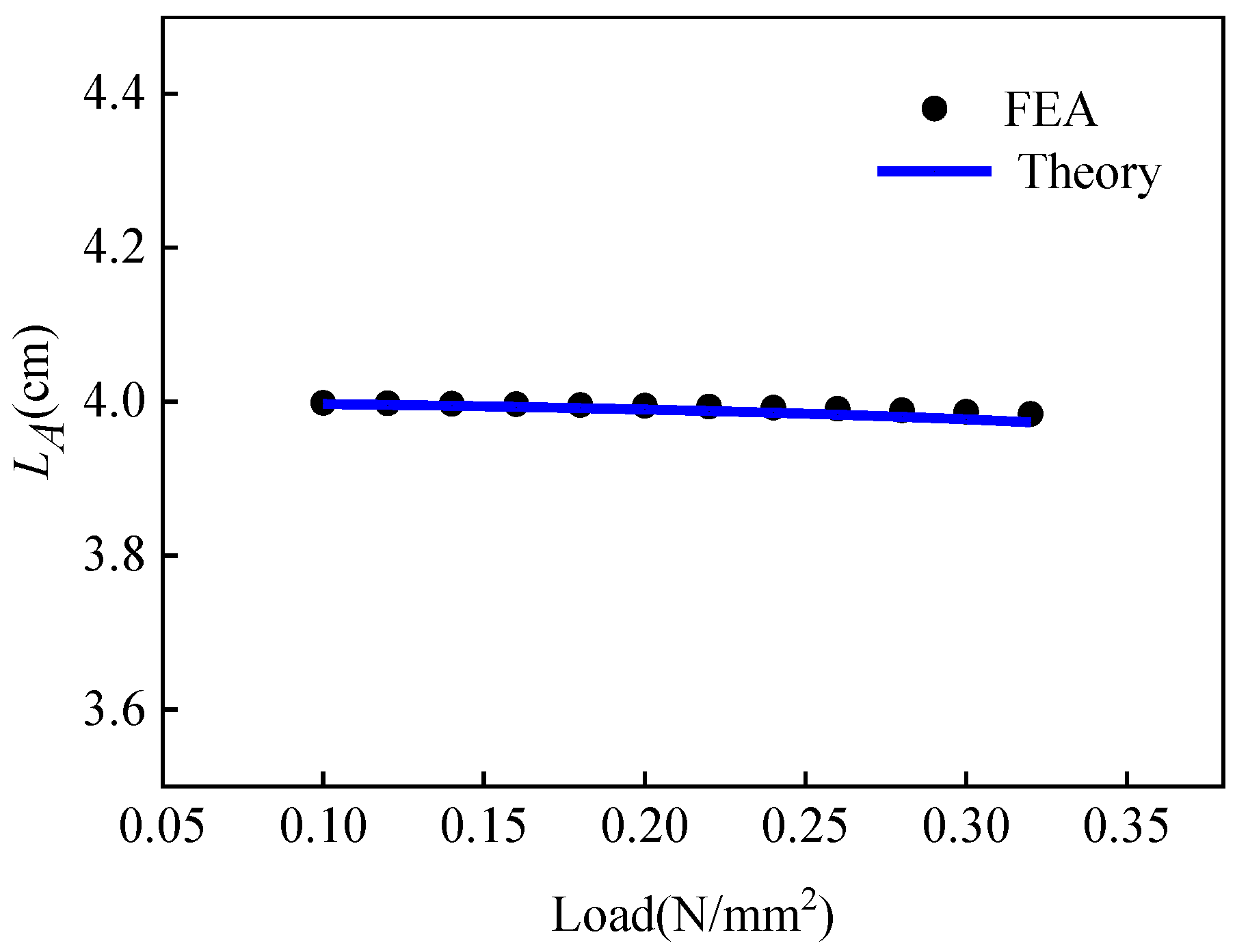

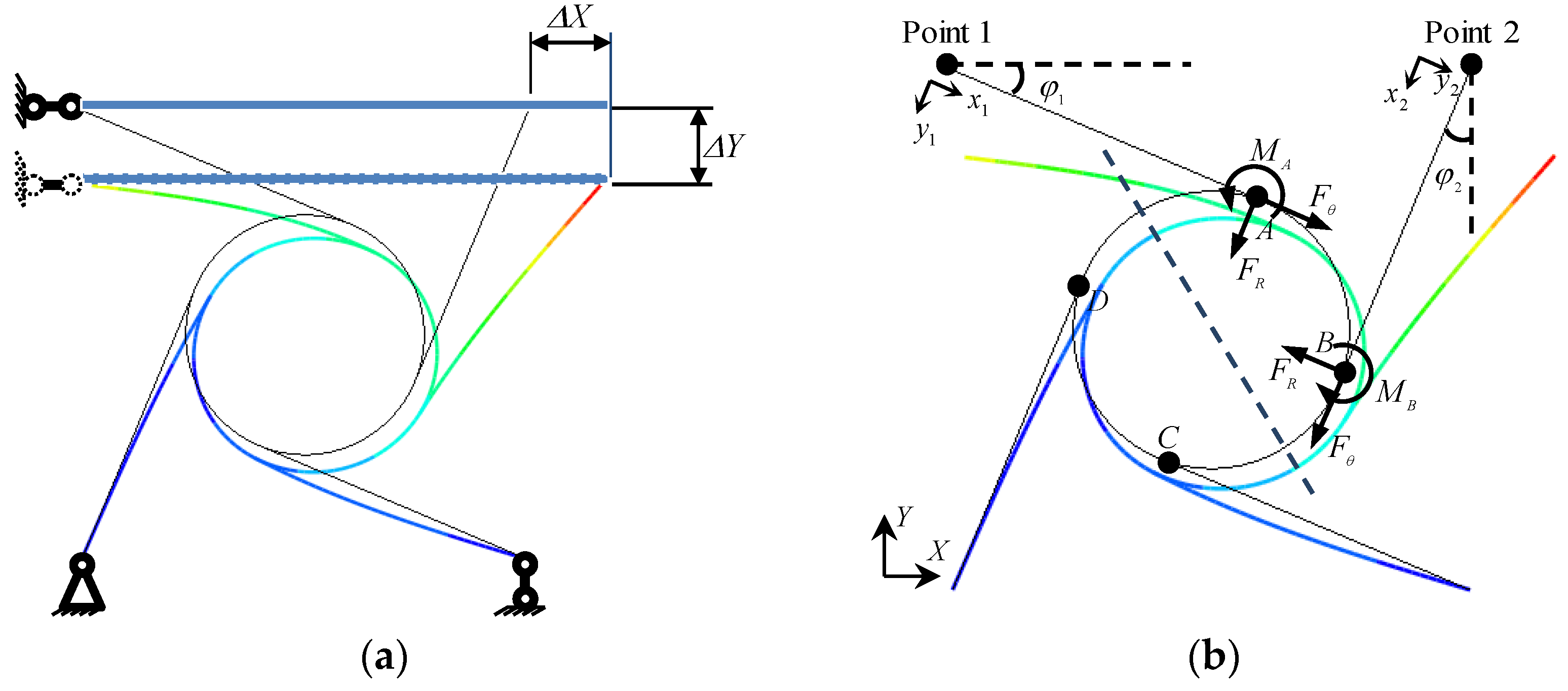
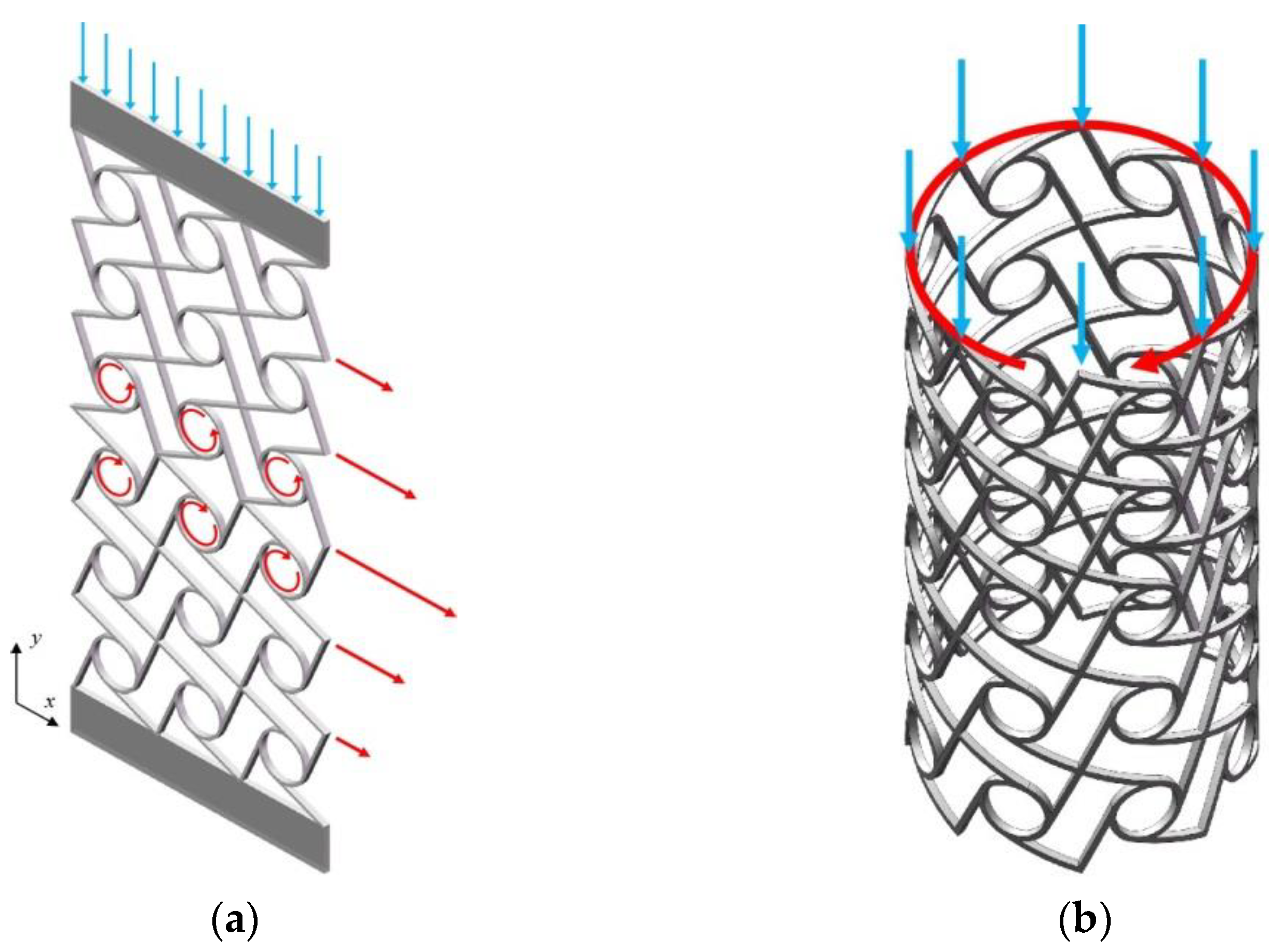
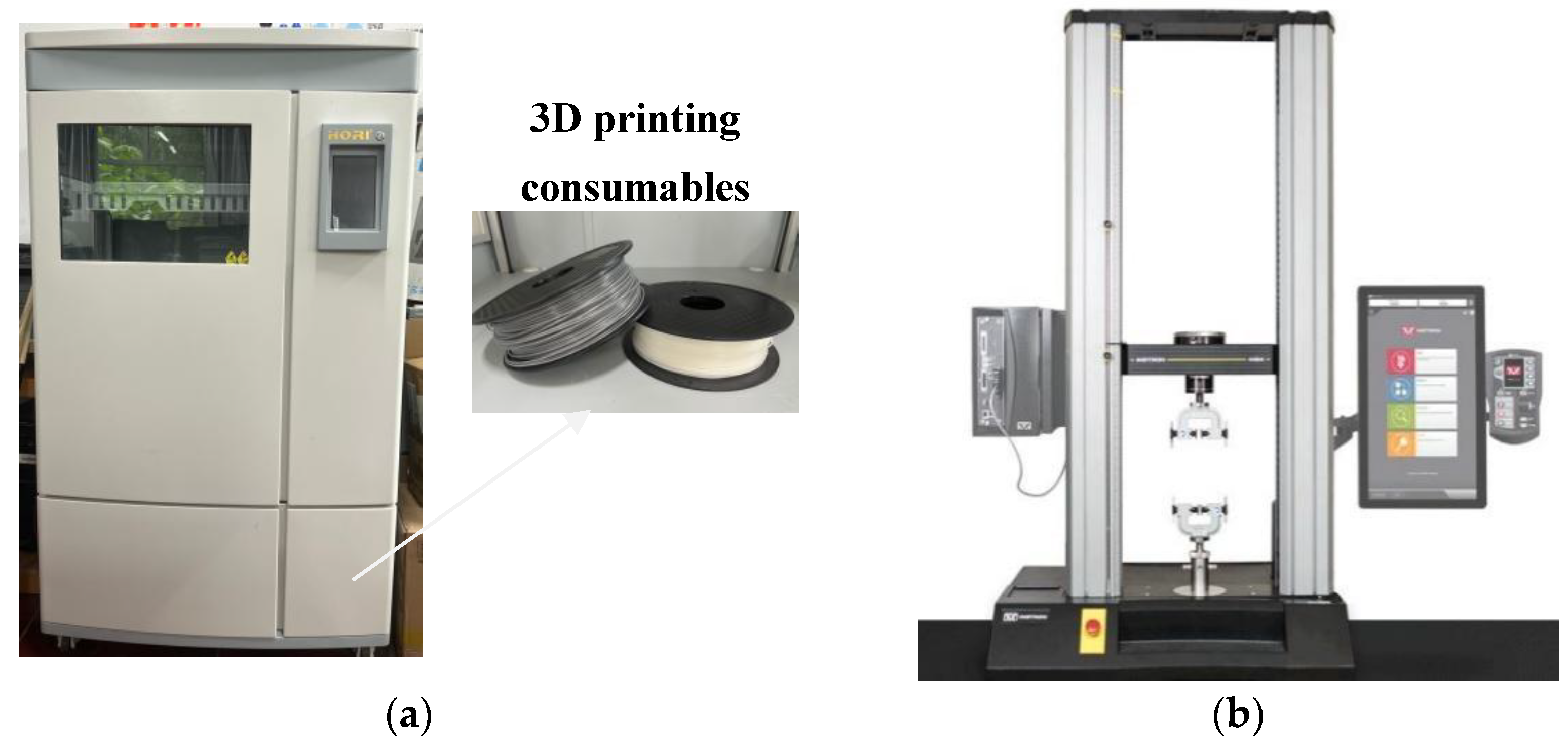

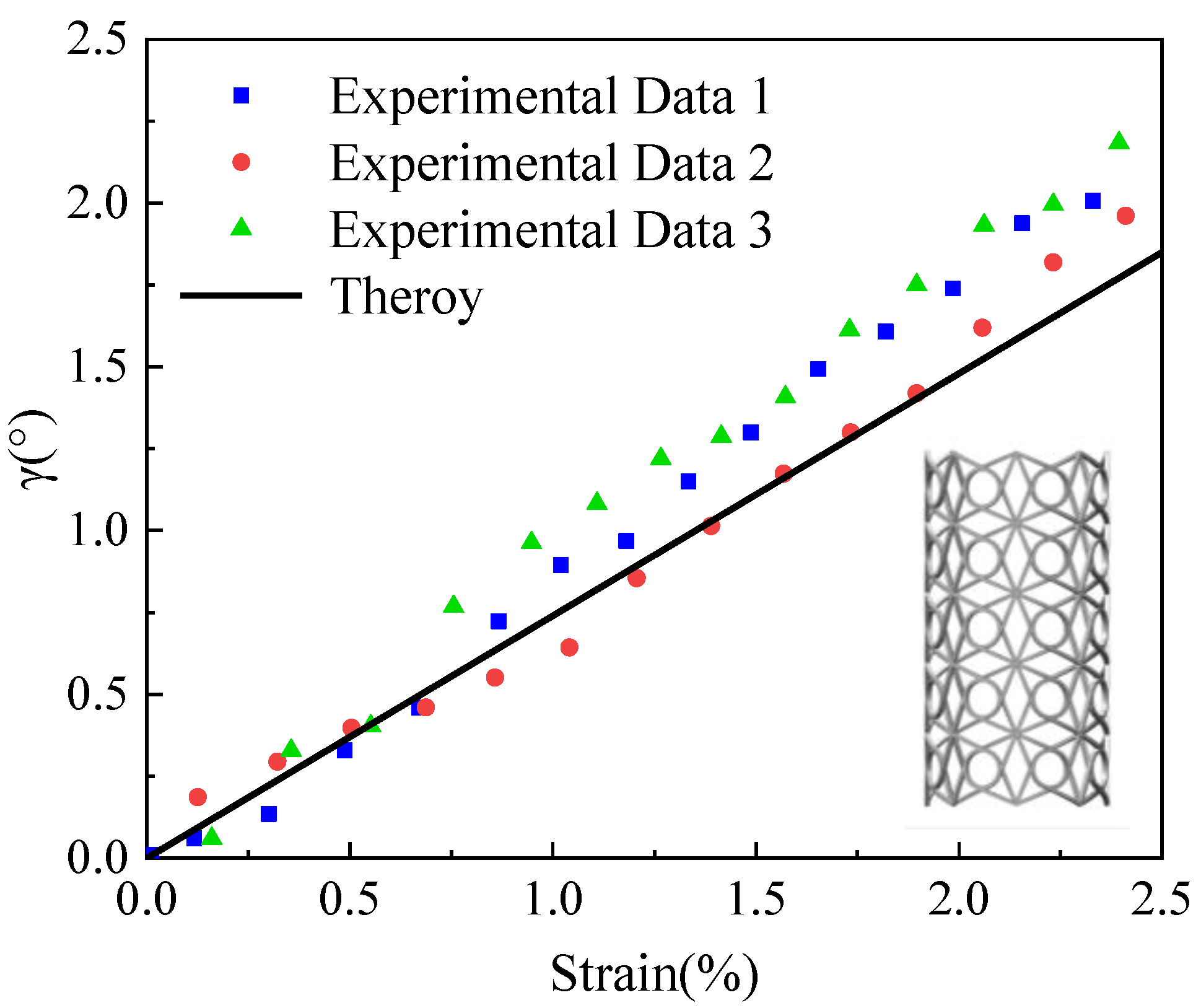
| Combined Configurations | Theoretical Solutions | Radial Displacement at Point ‘1’ (mm) | Tangential Displacement at Point ‘1’ (mm) | Radial Displacement at Point ‘2’ (mm) | Tangential Displacement at Point ‘2’ (mm) |
|---|---|---|---|---|---|
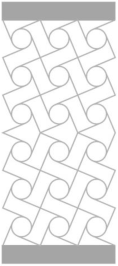 | Elliptic integral solution | 5.06 | 0.36 | 6.02 | 1.17 |
| Annular node ductile deformation | −0.14 | 1.08 | 0.13 | 1.55 | |
| Material properties | The material properties are photosensitive resin materials, the cell size is 30 mm × 30 mm, the Elastic modulus is 1404.70 MPa, and the Poisson’s ratio is 0.3. The diameter of the annular node is 16 mm, and the width of the ligament beam is 1 mm. | ||||
Publisher’s Note: MDPI stays neutral with regard to jurisdictional claims in published maps and institutional affiliations. |
© 2022 by the authors. Licensee MDPI, Basel, Switzerland. This article is an open access article distributed under the terms and conditions of the Creative Commons Attribution (CC BY) license (https://creativecommons.org/licenses/by/4.0/).
Share and Cite
Zhou, X.; Liang, X.; Liu, Z.; Tao, C.; Li, H. Compression Deformation Prediction of Chiral Metamaterials: A Compression–Shear Coupling Model. Materials 2022, 15, 5180. https://doi.org/10.3390/ma15155180
Zhou X, Liang X, Liu Z, Tao C, Li H. Compression Deformation Prediction of Chiral Metamaterials: A Compression–Shear Coupling Model. Materials. 2022; 15(15):5180. https://doi.org/10.3390/ma15155180
Chicago/Turabian StyleZhou, Xin, Xi Liang, Zeliang Liu, Chenglin Tao, and Huijian Li. 2022. "Compression Deformation Prediction of Chiral Metamaterials: A Compression–Shear Coupling Model" Materials 15, no. 15: 5180. https://doi.org/10.3390/ma15155180
APA StyleZhou, X., Liang, X., Liu, Z., Tao, C., & Li, H. (2022). Compression Deformation Prediction of Chiral Metamaterials: A Compression–Shear Coupling Model. Materials, 15(15), 5180. https://doi.org/10.3390/ma15155180





